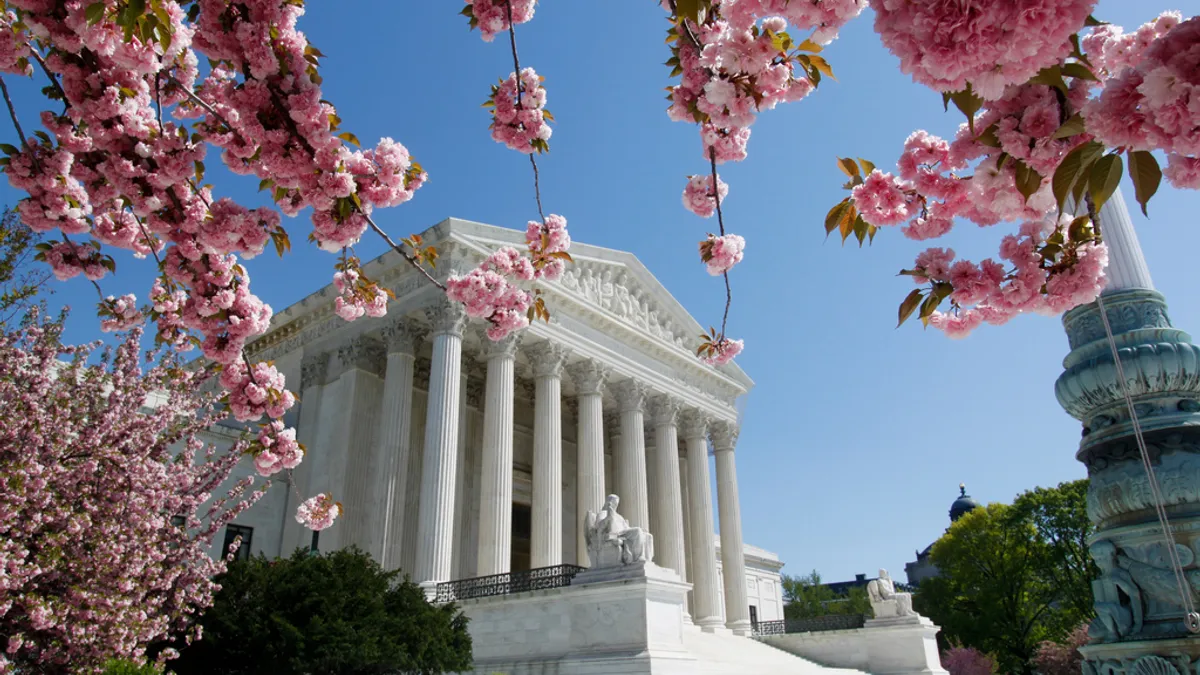A funny thing about the U.S. Supreme Court's most recent energy case: On paper it's about a gas plant, but in the long term the biggest implications could be for renewable energy. And the short term, it could wind up affecting Ohio coal plant contracts.
Hughes v. Talen Energy Marketing was the most complicated and lowest-profile of recent FERC cases to come before the Supreme Court, and it was decided on a narrow set of facts — ostensibly limiting its impacts. But already, opponents of power purchase agreements in Ohio are looking to use the decision to block subsidies. At the same time, renewable advocates are breathing a sigh of relief.
“The renewables community was concerned the Supreme Court might return a broad, open-ended decision that might be seen as limiting the ability of states to take actions to promote generation,” said Jennifer Mersing, an attorney in the energy development group at Stoel Rives. “But the court went out of its way to decide the case on very narrow grounds. … I don't see renewable programs under threat.”
Not everyone agrees with that sentiment. More litigation is almost certain, according to Travis Kavulla, vice-chair of the Montana Public Service Commission and president of the National Association of Regulatory Utility Commissioners.
In Kavulla's opinion, the specificity of the court's ruling essentially kicks the can down to the next case.
“That's the irony here: It's a very narrow ruling, but for the mere sake of its narrowness it begs a lot of questions,” he said. And he expects that at some point, the decision will be used to challenge renewable portfolio standards.
The case and ruling
The case in question began in 2011, when Maryland regulators feared a generation shortfall resulting from the expected retirement of coal resources. The state solicited offers, and selected Competitive Power Ventures, or CPV Maryland, to construct a new 650 MW gas-fired plant.
Maryland's contract stipulated a rate and directed CPV to bid the capacity into the PJM market. The load serving entities in the state would make up the difference if the clearing price for PJM auctions was lower than the contract price.
The “contract for differences” was the key in the Supreme Court's decision. Some utilities and the Obama administration said the deal artificially suppressed power prices and stepped into the sole jurisdiction of the Federal Energy Regulatory Commission (FERC) to regulate interstate power markets like the one operated by PJM.
A coalition of states and industry interests, on the other hand, said that invalidating the Maryland program would infringe on the state's right to ensure reliable power delivery and reasonable rates, while also putting at risk dozens of laws supporting generation in other states.
On April 19, the court ruled decisively in FERC's favor, issuing an 8-0 decision saying incentive program had overstepped its bounds.
In the decision, Justice Ruth Bader Ginsburg drew a line between the Maryland program and other state incentives. The state stepped into FERC's territory, she wrote, when it stipulated that the resource must bid into the wholesale market.
"Maryland’s program is rejected only because it disregards an interstate wholesale rate required by FERC," Ginsburg wrote. "Neither Maryland nor other States are foreclosed from encouraging production of new or clean generation through measures that do not condition payment of funds on capacity clearing the auction."
Kavulla noted the narrow nature of the decision in a statement that day.
“[F]ollowing the Supreme Court’s logic, it seems possible that the State of Maryland could have accomplished substantially the same result of obtaining new generating capacity in the state," he said, "just so long as it did not condition the generator’s compensation on the wholesale market’s clearing price for capacity."
Relief for renewables
In her decision, Ginsburg emphasized that the court was ruling on the Maryland program only, not considering the legality of other state laws supporting generation.
“We reject Maryland’s program only because it disregards an interstate wholesale rate required by FERC," she wrote. "We therefore need not and do not address the permissibility of various other measures states might employ to encourage development of new or clean generation.”
The narrowness of the decision was welcome news to renewable energy advocates, many of whom expressed concern after oral arguments that a broad decision could invalidate key state programs supporting clean generation. Among those incentive programs the court left on the table: tax incentives, land grants, direct subsidies, construction of state-owned generation facilities and re-regulation of the energy sector.
“So long as a state does not condition payment of funds on capacity clearing the auction, the state’s program would not suffer from the fatal defect that renders Maryland’s program unacceptable,” Ginsburg wrote.
But the court's decision to “not address” the other incentives does not necessarily mean they wont be challenged, Kavulla said.
“The court's opinion is certainly an invitation to litigate further because it articulates no definite principle,” said Kavulla. “It reiterates two conflicting propositions.” States have control of generation citing and procurement decisions; FERC, however, controls compensation at the wholesale level.
“More and more litigation will follow to ascertain where that fuzzy line is drawn,” Kavulla said. While the incentives behind Maryland's contract for differences and a renewable standard may look different, he said they essentially function the same way, requiring a load-serving entity to procure electricity.
“Taken to its natural extreme the court's opinion could be used to challenge renewable portfolio standards,” said Kavulla. “Those are policies which clearly impact the wholesale markets and the price at which energy clears the market.”
Mersing, however, disagreed. “Right now it would be a stretch to show how states' renewable portfolio standards would be seen as disregarding the wholesale rate,” she said.
“I'm not saying someone won't try and find a way to use the ruling to their benefit to challenge renewable standards, but that's an overly broad reading,” Mersing said. “It's more tied to direct interaction with wholesale markets. … You may have to be careful in the future, tying something directly to a FERC market, but I don't think that's what renewable portfolio standards do.”
“Just because something may have an indirect impact on the wholesale rate, that doesn't mean it's going to be struck down,” she said.
The next front: Ohio plant subsidies
While challenges to renewable energy mandates or incentives based on the Hughes ruling remain a possibility, stakeholders in Ohio are already planning for how the decision could affect a high-profile policy battle there.
FirstEnergy and American Electric Power recently convinced Ohio regulators to approve power purchase agreements guaranteeing income at seven coal plants and one nuclear plant — older facilities that are uncompetitive in PJM's markets.
Despite approval by the Public Utilities Commission of Ohio, the controversial proceeding is not likely over, with a variety of challenges still ahead. And while the Supreme Court's decision on the Maryland subsidy will definitely be cited in that fight, both sides are claiming the upper hand.
FirstEnergy spokesman Doug Colafella said the company was “encouraged” by the court's decision.
“The ruling supports our position that a regulated utility can take contractual ownership of unregulated generating assets, and bid those resources into PJM’s annual capacity auction,” he said.
AEP spokesperson Melissa McHenry offered a similar take: “The Supreme Court decision is helpful in supporting AEP Ohio’s position since it specifically points out that bilateral contracts like the AEP Ohio power purchase agreements are permissible.”
“The Supreme Court specifically pointed to bilateral contracts like the AEP Ohio PPAs (where the purchaser buys capacity) as being permissible,” McHenry said. “Maryland, in contrast, tried to change the FERC-approved rate and specifically conditioned payment on the generators’ capacity clearing the auction ... AEP Ohio’s PPA doesn’t have that condition.”
Environmental advocates, however, are likely to see more similarities than differences between the deals.
“The impact of what Ohio has done is very similar to what Maryland tried to do and the Supreme Court rejected ” said Shannon Fisk, managing attorney of Earthjustice's coal program.
Earthjustice has been opposing the Ohio power deals, and will be petitioning state regulators to reconsider. If the rehearing is denied by the Public Utilities Commission of Ohio, then the challenge will go to the Ohio Supreme Court. At the same time, several parties have petitioned FERC to examine the deal and rescind affiliate waivers granted to AEP and FirstEnergy which allowed the deals.
While the deals, approved just last month, would take time to work their way up to the level of a U.S. Supreme Court case, Fisk thinks the Hughes decision could have an impact in regulatory and lower court battles to come.
“The fight certainly continues, and I think the Supreme Court ruling raises more serious questions about this bailout,” Fisk said.























